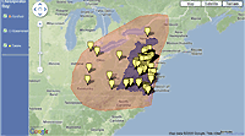Enforcement
Chesapeake Bay Compliance and Enforcement Strategy
Chesapeake Bay Executive Order
On May 12, 2009, President Barack Obama signed the Chesapeake Bay Protection and Restoration Executive Order
![]() recognizing the Chesapeake Bay as a national treasure and calling on the federal government to lead a renewed effort to restore and protect the nation's largest estuary and its watershed.
recognizing the Chesapeake Bay as a national treasure and calling on the federal government to lead a renewed effort to restore and protect the nation's largest estuary and its watershed.
The Order established a Federal Leadership Committee to oversee the development and coordination of reporting, data management and other activities by agencies involved in Bay restoration. The committee, chaired by EPA Administrator Lisa P. Jackson, also includes the departments of Agriculture, Commerce, Defense, Homeland Security, Interior, and Transportation.
The Chesapeake Bay is North America's largest and most biologically diverse estuary. This page describes EPA's strategy and activities to protect this national resource.
The Chesapeake Bay Watershed
The Chesapeake Bay is North America's largest and most biologically diverse estuary, home to more than 3,700 species of plants and animals. It is about 200 miles long, contains more than 11,000 miles of tidal shoreline, and is fed by 100,000 creeks, streams and rivers. The watershed spreads over 64,000 square miles and includes parts of six states - Delaware, Maryland, New York, Pennsylvania, Virginia, West Virginia - and all of the District of Columbia. Approximately 17 million people live within the Bay watershed. The Bay provides significant economic and recreational benefits, estimated to exceed $33 billion annually, to the watershed's population.
Environmental Pressures
The Bay and its tidal tributaries are threatened by pollution from a variety of sources overburdened with nutrients (nitrogen and phosphorus) and sediment. Excess nutrients fuel harmful algal blooms that rob the water of oxygen while sediment blocks sunlight from reaching underwater bay grasses. The main sources of nitrogen, phosphorus and sediment are agriculture, the largest source, urban and suburban runoff, wastewater, and airborne contaminants. Although many of these sources are not regulated by federal laws, some are required to control the pollution from their operations and are regulated by EPA's environmental laws.
For more information on the overall health of the Bay, see Chesapeake Bay Program, A Watershed Partnership Web site.
![]()
Chesapeake Bay Strategy
EPA has developed a Chesapeake Bay Compliance and Enforcement Strategy (PDF) (13 pp, 404K, About PDF). The Strategy guides the use of EPA's compliance and enforcement tools to target sources of pollution impairing the Bay. It is a multi-year and multi-state strategy combining our water, air and waste enforcement authorities to address violations of federal environmental laws resulting in nutrient, sediment and other pollution in the Bay. Under the Strategy, EPA will:
- Identify and address industrial, municipal, and agricultural sources releasing significant amounts of pollutants in excess of the amounts allowed by the Clean Water Act (CWA), the Clean Air Act (CAA) and other applicable environmental laws.
- Identify nutrient and sediment impaired sub-watersheds.
- Identify key regulated business sectors that, when in non-compliance with current applicable environmental regulations, contribute significant amounts of nutrients, sediment and other pollutants to the Bay. The key regulated sectors, some of which are also National Enforcement Initiatives for EPA, are:
- Concentrated Animal Feeding Operations (CAFO)
- Municipal and Industrial wastewater facilities
- Stormwater National Pollution Discharge Elimination System (NPDES) point sources including Municipal Separate Storm Sewer System (MS4s) and stormwater discharges from construction sites and other regulated industrial facilities
- Air deposition sources of nitrogen regulated under the Clean Air Act, including power plants
- Analyze the compliance records for facilities in the key regulated business sectors to target investigations and inspections.
- Investigate and inspect facilities in the key regulated business sectors and pursue appropriate enforcement actions to ensure compliance.
- Identify appropriate opportunities for compliance and enforcement activities related to the Clean Water Act wetlands protection program, federal facilities, and Superfund sites, including remedial action and removal sites, and Resource Conservation Recovery Act (RCRA) corrective action facilities.
- Explore opportunities for the use of imminent and substantial endangerment authorities under the Clean Water Act, Safe Drinking Water Act, Resource Conservation and Recovery Act, Superfund and the Clean Air Act.
For more information on Bay cases settled since 2009 see EPA's progress on Chesapeake Bay enforcement.

